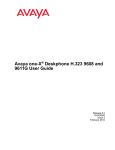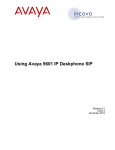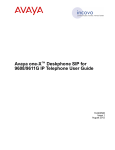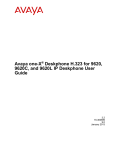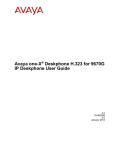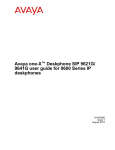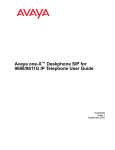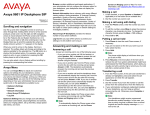Download Avaya 9400 Series Digital Deskphone User Guide
Transcript
Avaya 9400 Series Digital Deskphone User Guide for Avaya Aura® Communication Manager 16-603535 Issue 1 August 2011 © 2011 Avaya Inc. All Rights Reserved. Notice While reasonable efforts have been made to ensure that the information in this document is complete and accurate at the time of printing, Avaya assumes no liability for any errors. Avaya reserves the right to make changes and corrections to the information in this document without the obligation to notify any person or organization of such changes. Full legal page information For full support, please see the complete document, Avaya Support Notices for Hardware Documentation, document number 03–600759. To locate this document on our Web site, simply go to http:// www.avaya.com/support and search for the document number in the search box. Note Using a cell, mobile, or GSM phone, or a two-way radio in close proximity to an Avaya IP telephone might cause interference. Documentation disclaimer TO TAKE LEGAL ACTION AGAINST YOU AND ANYONE ELSE USING OR SELLING THE SOFTWARE WITHOUT A LICENSE. BY INSTALLING, DOWNLOADING OR USING THE SOFTWARE, OR AUTHORIZING OTHERS TO DO SO, YOU, ON BEHALF OF YOURSELF AND THE ENTITY FOR WHOM YOU ARE INSTALLING, DOWNLOADING OR USING THE SOFTWARE (HEREINAFTER REFERRED TO INTERCHANGEABLY AS “YOU” AND “END USER”), AGREE TO THESE TERMS AND CONDITIONS AND CREATE A BINDING CONTRACT BETWEEN YOU AND AVAYA INC. OR THE APPLICABLE AVAYA AFFILIATE ( “AVAYA”). Avaya grants End User a license within the scope of the license types described below. The applicable number of licenses and units of capacity for which the license is granted will be one (1), unless a different number of licenses or units of capacity is specified in the Documentation or other materials available to End User. “Designated Processor” means a single stand-alone computing device. “Server” means a Designated Processor that hosts a software application to be accessed by multiple users. “Software” means the computer programs in object code, originally licensed by Avaya and ultimately utilized by End User, whether as stand-alone Products or pre-installed on Hardware. “Hardware” means the standard hardware originally sold by Avaya and ultimately utilized by End User. License types Designated System(s) License (DS). End User may install and use each copy of the Software on only one Designated Processor, unless a different number of Designated Processors is indicated in the Documentation or other materials available to End User. Avaya may require the Designated Processor(s) to be identified by type, serial number, feature key, location or other specific designation, or to be provided by End User to Avaya through electronic means established by Avaya specifically for this purpose. “Documentation” means information published by Avaya in varying mediums which may include product information, operating instructions and performance specifications that Avaya generally makes available to users of its products. Documentation does not include marketing materials. Avaya shall not be responsible for any modifications, additions, or deletions to the original published version of documentation unless such modifications, additions, or deletions were performed by Avaya. End User agrees to indemnify and hold harmless Avaya, Avaya's agents, servants and employees against all claims, lawsuits, demands and judgments arising out of, or in connection with, subsequent modifications, additions or deletions to this documentation, to the extent made by End User. Shrinkwrap License (SR). Customer may install and use the Software in accordance with the terms and conditions of the applicable license agreements, such as “shrinkwrap” or “clickthrough” license accompanying or applicable to the Software (“Shrinkwrap License”). (see “Third-party Components” for more information). Link disclaimer Copyright Avaya is not responsible for the contents or reliability of any linked Web sites referenced within this site or documentation provided by Avaya. Avaya is not responsible for the accuracy of any information, statement or content provided on these sites and does not necessarily endorse the products, services, or information described or offered within them. Avaya does not guarantee that these links will work all the time and has no control over the availability of the linked pages. Except where expressly stated otherwise, no use should be made of materials on this site, the Documentation, Software, or Hardware provided by Avaya. All content on this site, the documentation and the Product provided by Avaya including the selection, arrangement and design of the content is owned either by Avaya or its licensors and is protected by copyright and other intellectual property laws including the sui generis rights relating to the protection of databases. You may not modify, copy, reproduce, republish, upload, post, transmit or distribute in any way any content, in whole or in part, including any code and software unless expressly authorized by Avaya. Unauthorized reproduction, transmission, dissemination, storage, and or use without the express written consent of Avaya can be a criminal, as well as a civil offense under the applicable law. Warranty Avaya provides a limited warranty on its Hardware and Software (“Product(s)”). Refer to your sales agreement to establish the terms of the limited warranty. In addition, Avaya’s standard warranty language, as well as information regarding support for this Product while under warranty is available to Avaya customers and other parties through the Avaya Support Web site: http://support.avaya.com. Please note that if you acquired the Product(s) from an authorized Avaya reseller outside of the United States and Canada, the warranty is provided to you by said Avaya reseller and not by Avaya. Licenses THE SOFTWARE LICENSE TERMS AVAILABLE ON THE AVAYA WEBSITE, HTTP://SUPPORT.AVAYA.COM/LICENSEINFO/ ARE APPLICABLE TO ANYONE WHO DOWNLOADS, USES AND/OR INSTALLS AVAYA SOFTWARE, PURCHASED FROM AVAYA INC., ANY AVAYA AFFILIATE, OR AN AUTHORIZED AVAYA RESELLER (AS APPLICABLE) UNDER A COMMERCIAL AGREEMENT WITH AVAYA OR AN AUTHORIZED AVAYA RESELLER. UNLESS OTHERWISE AGREED TO BY AVAYA IN WRITING, AVAYA DOES NOT EXTEND THIS LICENSE IF THE SOFTWARE WAS OBTAINED FROM ANYONE OTHER THAN AVAYA, AN AVAYA AFFILIATE OR AN AVAYA AUTHORIZED RESELLER; AVAYA RESERVES THE RIGHT 2 Third-party components Certain software programs or portions thereof included in the Product may contain software distributed under third party agreements (“Third Party Components”), which may contain terms that expand or limit rights to use certain portions of the Product (“Third Party Terms”). Information regarding distributed Linux OS source code (for those Products that have distributed the Linux OS source code), and identifying the copyright holders of the Third Party Components and the Third Party Terms that apply to them is available on the Avaya Support Web site: http://support.avaya.com/Copyright. Preventing Toll Fraud “Toll fraud” is the unauthorized use of your telecommunications system by an unauthorized party (for example, a person who is not a corporate employee, agent, subcontractor, or is not working on your company's behalf). Be aware that there can be a risk of Toll Fraud associated with Avaya 9400 Series Digital Deskphone User Guide Comments? [email protected] August 2011 your system and that, if Toll Fraud occurs, it can result in substantial additional charges for your telecommunications services. Avaya Toll Fraud Intervention If you suspect that you are being victimized by Toll Fraud and you need technical assistance or support, call Technical Service Center Toll Fraud Intervention Hotline at +1-800-643-2353 for the United States and Canada. For additional support telephone numbers, see the Avaya Support Web site: http://support.avaya.com. Suspected security vulnerabilities with Avaya products should be reported to Avaya by sending mail to: [email protected]. Trademarks All non-Avaya trademarks are the property of their respective owners, and “Linux” is a registered trademark of Linus Torvalds. Downloading Documentation For the most current versions of Documentation, see the Avaya Support Web site: http://support.avaya.com. Contact Avaya Support Avaya provides a telephone number for you to use to report problems or to ask questions about your Product. The support telephone number is 1-800-242-2121 in the United States. For additional support telephone numbers, see the Avaya Web site: http://support.avaya.com. Federal Communications Commission (FCC) Interference Statement This equipment has been tested and found to comply with the limits for a Class B digital device, pursuant to Part 15 of the FCC rules. These limits are designed to provide reasonable protection against harmful interference in a residential installation. This equipment generates, uses, and can radiate radio frequency energy and, if not installed and used in accordance with the instructions, may cause harmful interference to radio communications. However, there is no guarantee that interference will not occur in a particular installation. If this equipment does cause harmful interference to radio or television reception, which can be determined by turning the equipment off and on, the user is encouraged to try to correct the interference by one of the following measures: • Reorient or relocate the receiving antenna. • Increase the separation between the equipment and receiver. • Connect the equipment into an outlet on a circuit different from that to which the receiver is connected. • Consult the dealer or an experienced radio/TV technician for help. This device complies with Part 15 of the FCC Rules. Operation is subject to the following two conditions: (1) This device may not cause harmful interference, and (2) this device must accept any interference received, including interference that may cause undesired operation. FCC Caution: Any changes or modifications not expressly approved by the party responsible for compliance could void the user's authority to operate this equipment. Avaya 9400 Series Digital Deskphone User Guide August 2011 3 4 Avaya 9400 Series Digital Deskphone User Guide Comments? [email protected] August 2011 Contents Chapter 1: Introduction to the Avaya 9400 Series Digital Deskphones......................... 7 Overview of phone buttons and features.................................................................................................. 8 Description of LEDs.................................................................................................................................. 11 Description of icons in the telephone display............................................................................................ 12 Navigation tips........................................................................................................................................... 12 Chapter 2: Making calls...................................................................................................... 13 Making a call............................................................................................................................................. 13 Redialing a number................................................................................................................................... 13 Calling a person from the contacts list...................................................................................................... 14 Calling a person from the call history........................................................................................................ 14 Chapter 3: Handling calls................................................................................................... 15 Answering a call........................................................................................................................................ 15 Sending an incoming call directly to voicemail.......................................................................................... 16 Muting a call.............................................................................................................................................. 16 Putting a call on hold................................................................................................................................. 16 Transferring a call..................................................................................................................................... 17 Chapter 4: Using the conference feature.......................................................................... 19 Making a conference call.......................................................................................................................... 19 Adding a person on hold to a conference call........................................................................................... 19 Putting a conference call on hold.............................................................................................................. 20 Dropping the last participant from a conference call................................................................................. 20 Chapter 5: Getting your messages.................................................................................... 21 Logging into your voicemail...................................................................................................................... 21 Chapter 6: Using bridged call appearances..................................................................... 23 Answering a call on a bridged call appearance........................................................................................ 23 Joining a call on a bridged call appearance.............................................................................................. 23 Making an outgoing call on a bridged call appearance............................................................................. 24 Chapter 7: Using the contacts feature.............................................................................. 25 Viewing contact details.............................................................................................................................. 25 Adding a new contact................................................................................................................................ 25 Editing a contact........................................................................................................................................ 26 Deleting a contact..................................................................................................................................... 27 Adding an entry from the call history to your contacts list......................................................................... 27 Chapter 8: Using the call history feature.......................................................................... 29 Viewing the call history.............................................................................................................................. 29 Viewing call history details........................................................................................................................ 29 Adding an entry from the call history to your contacts list......................................................................... 30 Removing an entry from the call history.................................................................................................... 30 Clearing all entries from a call history list.................................................................................................. 30 Setting the call history feature................................................................................................................... 31 Chapter 9: Using advanced telephone features............................................................... 33 Forwarding calls........................................................................................................................................ 33 Sending all calls........................................................................................................................................ 33 Calling a person from the corporate directory........................................................................................... 34 Avaya 9400 Series Digital Deskphone User Guide August 2011 5 Activating Extension to Cellular (EC500).................................................................................................. 34 Chapter 10: Using the Avaya Home menu........................................................................ 35 Setting the Visual Alerting option.............................................................................................................. 35 Setting the Audible Alerting option ............................................................................................................ 36 Setting the Audio Path option................................................................................................................... 36 Setting the telephone screen behavior..................................................................................................... 37 Setting the telephone behavior when making a call from your contacts list.............................................. 38 Setting the call history feature................................................................................................................... 38 Customizing button labels......................................................................................................................... 40 Restoring default button labels................................................................................................................. 40 Adjusting the brightness of the telephone display..................................................................................... 41 Adjusting the contrast of the telephone display........................................................................................ 41 Changing the ringing pattern..................................................................................................................... 42 Setting the Button Clicks option................................................................................................................ 43 Setting the Error Tones option.................................................................................................................. 43 Erasing customized settings..................................................................................................................... 44 Verifying telephone operation................................................................................................................... 45 Changing the telephone display language................................................................................................ 45 Setting audio levels on the handset, headset, and speaker..................................................................... 46 Setting the Remote Headset option.......................................................................................................... 48 Setting the Echo Canceller option............................................................................................................. 49 Chapter 11: Using the BM12 button module..................................................................... 51 Answering a call........................................................................................................................................ 52 Making a call using an abbreviated dial button......................................................................................... 52 Adjusting the brightness of the button module display.............................................................................. 52 Adjusting the contrast of the button module display................................................................................. 53 Customizing button labels......................................................................................................................... 53 Using the feature buttons.......................................................................................................................... 54 Index..................................................................................................................................... 55 6 Avaya 9400 Series Digital Deskphone User Guide August 2011 Chapter 1: Introduction to the Avaya 9400 Series Digital Deskphones The Avaya 9400 Series Digital Deskphones are digital telephones for use by enterprises with the Avaya Aura® Communication Manager call processing system. These telephones put convenient features and capabilities at your fingertips, including a display to view and manage your calls, a contacts list, call history, a menu of options and settings to customize your telephone, and access to your voice mail. All features described in this user guide may not be available on your telephone. If you find that a feature is not available, contact your system administrator. Avaya 9400 Series Digital Deskphone User Guide August 2011 7 Introduction to the Avaya 9400 Series Digital Deskphones Overview of phone buttons and features Avaya 9404 telephone 8 Avaya 9400 Series Digital Deskphone User Guide Comments? [email protected] August 2011 Overview of phone buttons and features Avaya 9408 telephone No. Name of button or feature Description 1 Call/Message An illuminated red light in the upper-right corner of your phone Waiting Indicator indicates you have voicemail messages waiting. This light flashes when you receive an incoming call. In addition to the Message Waiting Indicator, the Message button is also illuminated when you have voice mail messages waiting. 2 Feature Buttons and Call Appearance Buttons There are 4 (9404) or 8 (9408) buttons that can be programmed as either call appearance buttons or feature buttons. Press a call appearance button to make or answer a call or resume a call on hold. Press a labeled feature button to enable or disable that feature. The feature buttons provide access to the Avaya call management system features that have been administered for your extension. The green LED next to each function key indicates whether the feature is currently on or off. If the light is on, the feature is on. For more information about the feature buttons, see Using advanced telephone features on page 33. 3 Softkeys Press the softkeys to select the softkey labels. The softkey labels indicate the action that each softkey produces. The labels and the actions vary depending on your selection. Avaya 9400 Series Digital Deskphone User Guide August 2011 9 Introduction to the Avaya 9400 Series Digital Deskphones No. 10 Name of button or feature Description 4 OK Press the OK button for a shortcut to an action. For example, select an entry from your call history and press OK to dial the number. 5 Phone Press the Phone button to view and manage your calls. For example, if you are viewing a menu, pressing the Phone button takes the telephone display back to the home screen. 6 Contacts Press the Contacts button to view the entries in your Contacts list. 7 Avaya Home Press the Home button to gain access to the Avaya menu. The Avaya menu provides options that you can use to customize telephone settings, configure call logging, select the display language, and verify the telephone operation. 8 History Press the History button to view a list of all your calls. The icon on the History button lights up when you have missed calls. 9 Volume Press + or - on the Volume button while active on the handset, headset or speaker to adjust the volume of the speaker or ringer. 10 Mute Press the Mute button to mute a call in progress or reactivate a muted call. 11 Microphone The omnidirectional microphone sends and receives signals from all directions. 12 Speaker Press the Speaker button to use the speakerphone. To take a call off speakerphone, lift the handset. 13 Headset Press the Headset button to use the headset if it is connected. For wired headsets, only HIC headset cords are compatible with your phone. 14 Message Press the Message button to connect directly to your voicemail system. This button is illuminated when you have voicemail messages waiting. 15 Navigation Arrows Press the up and down navigation arrows to scroll through lists. Press the right and left navigation arrows to navigate between different views of an application, to move the cursor during text input, or to turn an option on or off. 16 Telephone Display There are four rows in the 9404 telephone display and eight rows in the 9408 telephone display. The top row shows the extension number, user name and the time and date. On the 9404 telephone, the top row also provides application-specific information. The middle two rows in the 9404 telephone display and the middle six rows in the 9408 telephone display provide application-specific information. The second and the third rows Avaya 9400 Series Digital Deskphone User Guide Comments? [email protected] August 2011 Description of LEDs No. Name of button or feature Description in both telephone displays provide the name of the current application (for example, contacts) and a prompt line that provides context-sensitive prompts, explanations, or help for the current application. The bottom line displays the softkey labels. Description of LEDs Each call appearance button and feature button has two LEDs, one green and one red, to indicate the status of the call appearance or feature. The status is identified by whether the LED is on, off, or blinking, as described in the following tables. Call appearance button LEDs LED Description Steady green Call appearance is active. Slow blinking green Call appearance is ringing. Fast blinking green Call appearance is on hold. Very fast blinking green Conference or Transfer is pending. Steady red Call appearance is selected and will be used when you go offhook. It remains steady red while you use the call appearance. Off Call appearance is available. Feature button LEDs LED Description Steady green Feature is active. Blinking green Feature is pending (request is being processed and not immediately available). Blinking red Feature is shown on the phone display. Off Feature is not active. Avaya 9400 Series Digital Deskphone User Guide August 2011 11 Introduction to the Avaya 9400 Series Digital Deskphones Description of icons in the telephone display Icons are provided in the telephone display to indicate call status and navigation choices. The icons that appear in the phone display are described in the following table. Icon Description Missed call. Incoming call is ringing. Call is active. Call is on hold. Call is on soft hold (when using Conference or Transfer feature). History incoming call. History outgoing call. Indicates feature button is active. Indicates feature button is active. Scroll left or right for other options. Scroll up or down for other options. Navigation tips To navigate through the options and features on your telephone display, use the navigation arrows to scroll and the OK button to select lines or options. A navigation icon appears in the telephone display to indicate that you can scroll to more options or information. Use the right and left navigation arrows to go to other screens when the paging icon (left- and right-facing arrows) displays on the title line or to move the cursor right or left when entering text. When you scroll to a line on the display, that line is selected. The softkey labels change according to the options available for the line you select. The OK button is a shortcut for the default action. For example, when you select an entry in your contacts list, pressing the OK button places a call to that person. 12 Avaya 9400 Series Digital Deskphone User Guide Comments? [email protected] August 2011 Chapter 2: Making calls Use the procedures in this chapter to make calls from your telephone. Making a call About this task Procedure 1. Do one of the following: • Lift the handset. • Press the Speaker button. • Press the Headset button. • Press an available call appearance button. 2. Dial the number you want to call. Redialing a number Procedure To redial the last number dialed, press the Redial softkey. Avaya 9400 Series Digital Deskphone User Guide August 2011 13 Making calls Calling a person from the contacts list Procedure 1. Press the Contacts button. 2. Locate the contact you want by typing the first letter of the contact's name as it is listed. For example, if you added John Smith to your contacts list as “Smith, John” you would type s, the first letter of his last name. 3. Scroll up or down to select the person or number you want to call. 4. Press the OK button or the Call softkey. Calling a person from the call history Procedure 1. Press the History button. 2. Scroll to the left or right to view a separate list of all calls, missed (unanswered) calls, answered calls, or outgoing calls. 3. Scroll up or down to select the person or number you want to call. 4. Press the Call softkey or the OK button. 14 Avaya 9400 Series Digital Deskphone User Guide Comments? [email protected] August 2011 Chapter 3: Handling calls Use the procedures in this chapter to handle calls from your telephone. This includes procedures such as answering a call, muting a call, and transferring a call. Answering a call About this task When you receive an incoming call, the green LED associated with the call will flash. The incoming call is usually selected automatically. However, if you are already on a call or if you receive more than one incoming call at a time, you may need to select the call you want to answer manually. • If you are not on another call, do one of the following: - Lift the handset. - Press the call appearance button whose green LED flashes for the incoming call. - Press the Speaker button to answer using the speakerphone. - Press the Headset button to answer using the headset. - Press the ON button to answer using a wireless headset. • If you are on another call, press the call appearance button whose green LED flashes for the incoming call. Note: If the Auto Hold (Communication Manager) feature is enabled by your system administrator, you can answer another call without first putting an active call on hold. If Auto Hold is not enabled, you must put your active call on hold before answering the incoming call; otherwise, you will drop the active call when you answer the incoming call. Avaya 9400 Series Digital Deskphone User Guide August 2011 15 Handling calls Sending an incoming call directly to voicemail Procedure To send an incoming call directly to voicemail without answering, press the To Vmail softkey. Note: To send incoming calls directly to voicemail, your voicemail must be administered as the first entry in your coverage path. See your system administrator for more information. Muting a call Procedure 1. Press the Mute button during a call so that the other person on the call cannot hear you. 2. Press the Mute button again to unmute the call. Note: If a call is on mute and you switch between the handset, headset, or speakerphone, the mute will be turned off. Putting a call on hold Procedure 1. To put your active call on hold, press the Hold softkey. The fast blinking green LED next to the call appearance button indicates the call is on hold. 2. To resume the call, press the call appearance button for the call on hold. 16 Avaya 9400 Series Digital Deskphone User Guide Comments? [email protected] August 2011 Transferring a call Transferring a call Procedure 1. If the call you want to transfer is not your active call, press the call appearance button for the call you want to transfer. 2. Press the Transfer softkey. The very fast blinking green LED next to the call appearance button indicates the call is being transferred. 3. Do one of the following: • Dial the telephone number. • Call the person from the contacts list. • Call the person from the call history. Note: To transfer the call to a call that is on hold, press the call appearance button for the call that is on hold. 4. Press the Transfer softkey to transfer the call. Once the transfer is complete, Transfer Completed appears in the phone display. Avaya 9400 Series Digital Deskphone User Guide August 2011 17 Handling calls 18 Avaya 9400 Series Digital Deskphone User Guide Comments? [email protected] August 2011 Chapter 4: Using the conference feature You can use conference calls to speak with people from different locations on the same call. Additional conferencing options may be available through Expanded Meet-Me Conferencing. Contact your system administrator for more information about this feature. Making a conference call Procedure 1. While active on a call, press the Conf softkey. The very fast blinking green LED next to the call appearance button indicates the call is being conferenced. 2. Do one of the following: • Dial the telephone number. • Call the person from the contacts list. • Call the person from the call history. 3. Press the Conf softkey to add the person to the existing call. Adding a person on hold to a conference call Procedure 1. Select the call appearance button for your active conference call. 2. Press the Conf softkey. The active conference call is put on soft hold. 3. Press the call appearance button of the call on hold. Be sure not to choose the call appearance button for the call that is on soft hold. 4. Press the Conf softkey again to add the person to the conference call. Avaya 9400 Series Digital Deskphone User Guide August 2011 19 Using the conference feature Putting a conference call on hold About this task When you put a conference call on hold, the other parties can still talk to each other. Procedure 1. Press the Hold softkey during a conference call. The blinking green LED next to the call appearance button indicates the conference is on hold. 2. Press the call appearance button to resume the conference call. Dropping the last participant from a conference call Procedure While active on a conference call, press the Drop softkey. 20 Avaya 9400 Series Digital Deskphone User Guide Comments? [email protected] August 2011 Chapter 5: Getting your messages Use the Message button to connect to your voicemail system. When you have messages waiting, the Message button is illuminated. The red light on the upper right corner of your telephone is also illuminated when you have messages waiting. The voicemail system and messaging functions are administered by your system administrator. Contact your system administrator with any questions. Logging into your voicemail Procedure 1. To log in to your voicemail, press the Message button. 2. Follow the voice prompts from your voicemail system. Avaya 9400 Series Digital Deskphone User Guide August 2011 21 Getting your messages 22 Avaya 9400 Series Digital Deskphone User Guide Comments? [email protected] August 2011 Chapter 6: Using bridged call appearances In addition to your own call appearances, your phone may show one or more bridged call appearances on the display screen. A bridged call appearance typically belongs to someone else, but bridging allows you to see if that call appearance is in use, answer calls on that appearance, or join a call in progress on that call appearance from your telephone. You can also make outgoing calls on a bridged call appearance when it is not in use. Answering a call on a bridged call appearance About this task Answering a call on a bridged call appearance is basically the same as answering a call on a primary line. If the ringing bridged call appearance is selected, you can answer by picking up the handset or by pressing the Speaker or Headset button. Procedure To answer a call on a bridged call appearance, press the call appearance button associated with the bridged call appearance. Note: The ringing bridged call appearance may be selected automatically if there are no other active calls. If you are on another call when a call comes in to a bridged call appearance, you may have to select the ringing bridged call appearance button. Joining a call on a bridged call appearance Procedure 1. Scroll to the call in progress that you want to join. 2. Press the call appearance button for the bridged call appearance. Avaya 9400 Series Digital Deskphone User Guide August 2011 23 Using bridged call appearances Making an outgoing call on a bridged call appearance About this task When you make a call on a bridged call appearance, you are using another telephone user’s call appearance. The caller ID associated with the call you are making may show the call as coming from you or coming from the person whose call appearance you are using. If you have any questions about how the name or extension displays to the person you are calling, contact your system administrator. Procedure 1. Press the call appearance button associated with the bridged call appearance. 2. Do one of the following: • Dial the telephone number. • Call the person from the contacts list. • Call the person from the call history. 24 Avaya 9400 Series Digital Deskphone User Guide Comments? [email protected] August 2011 Chapter 7: Using the contacts feature You can save up to 100 names and telephone numbers. For additional information, see Calling a person from the contacts list on page 14. Viewing contact details Procedure 1. Press the Contacts button. 2. Scroll to the contact you want to view. Names are listed alphabetically by first name. To return to the top of the list, press the Contacts button again. 3. Do one of the following: • For the 9408 telephone, press the Details softkey to see the contact name and number. • For the 9404 telephone, press the Details softkey to see the contact name, and then scroll down to see the contact number. Adding a new contact Procedure 1. Press the Contacts button. Note: If this is the first contact you are adding, go to step 3. 2. Press the More softkey. 3. Press the New softkey. 4. Enter the name using the dialpad. To enter characters using the dialpad: Avaya 9400 Series Digital Deskphone User Guide August 2011 25 Using the contacts feature • Press the number key that corresponds to the letter or number you want to enter until the letter or number is displayed. • If the characters are on the same key, pause before entering the next character. • To enter a space, press 0. • Enter remaining letters or numbers. • To delete the last character, press the More softkey and then the Bksp softkey. Note: If you want to remove a letter, number, space, or symbol that is in the middle of the text you entered, use the left and right navigation arrows to place your cursor after the character you want to remove. Once your cursor is in the correct position, press the Bksp softkey to remove the character to the left of the cursor. 5. Press the down navigation arrow. 6. Enter the telephone number as you would if you were dialing it directly. 7. Press the Save softkey to save your changes. Editing a contact Procedure 1. Press the Contacts button. 2. Scroll to the contact you want to edit. 3. Press the Details softkey. 4. Press the Edit softkey. 5. Scroll up or down to choose the field you want to edit. 6. Use the dialpad and softkeys to make changes to the contact information. 7. Press the Save softkey to save your changes. 26 Avaya 9400 Series Digital Deskphone User Guide Comments? [email protected] August 2011 Deleting a contact Deleting a contact Procedure 1. Press the Contacts button. 2. Scroll to the contact you want to delete. 3. Press the More softkey. 4. Press the Delete softkey. 5. Press the Delete softkey again to confirm. Note: If you press the Cancel softkey prior to pressing the Delete softkey, your contact information will not be removed. Adding an entry from the call history to your contacts list Procedure 1. Press the History button. 2. Scroll to the number you want to add to your contacts list. 3. Press the +Contact softkey. If your contacts list is full, the +Contact softkey is not displayed. 4. To edit the name or number, scroll up or down and edit as appropriate. 5. Press the Save softkey to save your changes. Avaya 9400 Series Digital Deskphone User Guide August 2011 27 Using the contacts feature 28 Avaya 9400 Series Digital Deskphone User Guide Comments? [email protected] August 2011 Chapter 8: Using the call history feature You can use the call history to view separate lists of your outgoing calls, all calls, missed (unanswered) calls, or answered calls. For information about turning call logging on and off for different call types, see Setting the call history feature on page 31. Viewing the call history Procedure 1. Press the History button. You can go to the top of the list by pressing the History button again. 2. Scroll to the left or right to view a separate list of outgoing calls, all calls, missed (unanswered) calls, or answered calls. Viewing call history details Procedure 1. Press the History button. 2. Scroll to the number you want to view. 3. Do one of the following: • For the 9408 telephone, press the Details softkey to view the name, number, time, date, and duration of the call. • For the 9404 telephone, press the Details softkey to view the name and number. Then scroll down one line at a time to view the date and time of the call and then the duration of the call. 4. Press the Back softkey to return to the list view. Avaya 9400 Series Digital Deskphone User Guide August 2011 29 Using the call history feature Adding an entry from the call history to your contacts list Procedure 1. Press the History button. 2. Scroll to the number you want to add to your contacts list. 3. Press the +Contact softkey. If your contacts list is full, the +Contact softkey is not displayed. 4. To edit the name or number, scroll up or down and edit as appropriate. 5. Press the Save softkey to save your changes. Removing an entry from the call history Procedure 1. Press the History button. 2. Select the number you want to delete. 3. Press the More softkey. 4. Press the Delete softkey. 5. Press the Delete softkey again to confirm. Clearing all entries from a call history list About this task Clearing all entries from the call history deletes all of the entries for the specific list you are viewing. For example, if you are viewing the Outgoing calls list, only outgoing calls are deleted from the call history. You are also able to clear all calls from the entire call history. 30 Avaya 9400 Series Digital Deskphone User Guide Comments? [email protected] August 2011 Setting the call history feature Procedure 1. Press the History button. 2. To delete entries from a specific list: a. Select the list whose entries you want to delete. b. Press the More softkey. c. Press the Clear All softkey to delete all of the entries in the list you are viewing. d. Press the Clear All softkey again to confirm. Setting the call history feature About this task You can set the call history feature to log answered, unanswered, outgoing, or bridged calls. The option to log bridged calls is available only if your telephone is configured with bridged call appearances. You can turn call logging on or off for any of these call types. Procedure 1. Press the Home button. 2. Scroll to Applications Settings. 3. Press the Select softkey or the OK button. 4. Do one of the following: a. To turn the Log Answered option on or off, with this option selected, do one of the following: • Press the Change softkey. • Press the OK button. • Press the associated call appearance/feature button. • Press the right or left navigation arrow. When set to On, all answered calls are stored in the call history. b. To turn the Log Unanswered option on or off, scroll to this option, and then do one of the following: • Press the Change softkey. • Press the OK button. • Press the associated call appearance/feature button. Avaya 9400 Series Digital Deskphone User Guide August 2011 31 Using the call history feature • Press the right or left navigation arrow. When set to On, all unanswered calls are stored in the call history. c. To turn the Log Outgoing option on or off, scroll to this option, and then do one of the following: • Press the Change softkey. • Press the OK button. • Press the associated call appearance/feature button. • Press the right or left navigation arrow. When set to On, all outgoing calls are stored in the call history. d. To turn the Log Bridged option on or off, scroll to this option, and then do one of the following: • Press the Change softkey. • Press the OK button. • Press the associated call appearance/feature button. • Press the right or left navigation arrow. When set to On, all incoming and outgoing calls on bridged call appearances are stored in the call history. Note: The Log Bridged option is available only if your telephone has bridged call appearances. 5. Press the Save softkey to save your changes. 6. To turn call logging on or off for another call type, repeat Steps 3 through 5. 32 Avaya 9400 Series Digital Deskphone User Guide Comments? [email protected] August 2011 Chapter 9: Using advanced telephone features Avaya call management systems provide many advanced telephone features such as Directory, Call Forwarding, and Abbreviated Dial buttons.These features are administered on the feature buttons on your telephone. The features that are available to you depend on what your administrator has assigned to your telephone. A few of the most commonly administered features are explained below. For more information about all the features that are available for your extension, contact your system administrator. Forwarding calls About this task The Call Forward feature allows you to forward your incoming calls to another number. You must enter the telephone number where the calls will be forwarded each time you activate this feature. You can forward calls only to internal numbers. Procedure 1. To turn call forwarding on, press the CFrwd feature button. You hear a dial tone prompting you to dial the forwarding number. 2. Dial the number to which you want to forward your calls. After you dial the number, you hear a confirmation tone. The green LED next to the feature button turns on. 3. To turn call forwarding off, press the CFrwd feature button. The green LED next to the feature button turns off. Sending all calls About this task The Send All Calls (SAC) feature allows you to send all of your incoming calls directly to a predefined coverage number, typically your voice mail. Incoming calls ring once at your extension and then go directly to a number which is set by your system administrator. Avaya 9400 Series Digital Deskphone User Guide August 2011 33 Using advanced telephone features • To send all calls to coverage, press the SAC feature button. The green LED next to the feature button turns on. • To turn the feature off, press the SAC feature button. The green LED next to the feature button turns off. Calling a person from the corporate directory About this task The Directory feature allows you to dial other users in your system by name. Procedure 1. Press the Directory feature button. 2. Use the dialpad keys to start spelling the last name of the person you want to call. Press each dialpad key one time for each corresponding letter. For example, for “Hill”, press 4,4,5,5. 3. Press the Next feature button to view the next name alphabetically in the directory, if necessary. 4. Press the Make Call feature button when you see the name you want. 5. To exit the Directory, press the Phone button or the Exit softkey. Activating Extension to Cellular (EC500) About this task The Extension to Cellular (EC500) feature allows you to have incoming calls ring on your office telephone and your cell phone at the same time. This allows you to answer office calls while you are away from your desk. The cell phone number is programmed by your system administrator. Procedure 1. To turn the EC500 feature on, press the EC500 feature button. The green LED next to the feature button turns on. 2. To turn the EC500 feature off, press the EC500 feature button. The green LED next to the feature button turns off. 34 Avaya 9400 Series Digital Deskphone User Guide Comments? [email protected] August 2011 Chapter 10: Using the Avaya Home menu Use the Avaya Home menu to perform tasks such as adjust and customize phone settings, select the display language, turn call logging on or off for different call types, and set visual and audible alerting. The Avaya Home menu has four sub-menus: Call Settings Lets you set the visual alerting, audible alerting, show phone screen, and stay in contacts options to on or off; and set the audio path to speakerphone or headset. Application Settings Lets you turn call logging on and off for answered, unanswered, outgoing, and bridged calls; and personalize button labels or restore the default button labels. Screen & Sounds Lets you adjust the display brightness and contrast, select your ringing pattern, turn button click sounds on and off, and turn error tones on and off. Advanced Options Lets you erase customized settings, perform a telephone self-test, select the display language, set audio levels for different environments, set the remote headset option, and enable a higher quality voice transmission. Note: The sub-menus that appear depend on how your extension was administered. Some sub-menus may not be available. Setting the Visual Alerting option About this task When the Visual Alerting option is turned on, incoming calls cause the LED in the top right corner of the phone to flash. You can turn visual alerting on or off. Procedure 1. Press the Home button. 2. Scroll to Call Settings. 3. Press the Select softkey or the OK button. 4. Scroll to Visual Alerting. 5. To turn visual alerting on or off, do one of the following: • Press the Change softkey. Avaya 9400 Series Digital Deskphone User Guide August 2011 35 Using the Avaya Home menu • Press the OK button. • Press the associated call appearance/feature button. • Press the right or left navigation arrow. 6. Press the Save softkey to save your changes. Setting the Audible Alerting option About this task When the Audible Alerting option is turned on, the telephone rings when an incoming call arrives. When the Audible Alerting option is turned off, the telephone does not ring when a call arrives, and the Visual Alerting option is automatically turned on. Procedure 1. Press the Home button. 2. Scroll to Call Settings. 3. Press the Select softkey or the OK button. 4. Scroll to Audible Alerting. 5. To turn audible alerting on or off, do one of the following: • Press the Change softkey. • Press the OK button. • Press the associated call appearance/feature button. • Press the right or left navigation arrow. 6. Press the Save softkey to save your changes. Setting the Audio Path option About this task You can set the audio path of your phone so that when you initiate a call, the audio path automatically goes to either the speakerphone or your headset. 36 Avaya 9400 Series Digital Deskphone User Guide Comments? [email protected] August 2011 Setting the telephone screen behavior Procedure 1. Press the Home button. 2. Scroll to Call Settings. 3. Press the Select softkey or the OK button. 4. Scroll to Audio Path. 5. To set the audio path to headset or speaker, do one of the following: • Press the Change softkey. • Press the OK button. • Press the associated call appearance/feature button. • Press the right or left navigation arrow. 6. Press the Save softkey to save your changes. Setting the telephone screen behavior About this task When the Show Phone Screen option is turned on, and an incoming call arrives, the telephone display will exit the contacts application, call log, or any menu that is open. If you want to remain in the contacts application, call log, or menu when an incoming call arrives, turn this option off. Procedure 1. Press the Home button. 2. Scroll to Call Settings. 3. Press the Select softkey or the OK button. 4. Scroll to Show Phone Screen. 5. To turn the Show Phone Screen option on or off, do one of the following: • Press the Change softkey. • Press the OK button. • Press the associated call appearance/feature button. • Press the right or left navigation arrow. 6. Press the Save softkey to save your changes. Avaya 9400 Series Digital Deskphone User Guide August 2011 37 Using the Avaya Home menu Setting the telephone behavior when making a call from your contacts list About this task When the Stay in Contacts option is turned on, and you make a call from your contacts list, the telephone will stay in the contacts application. If you want the telephone to exit the contacts application when you make a call from your contacts list, turn this option off. Procedure 1. Press the Home button. 2. Scroll to Call Settings. 3. Press the Select softkey or the OK button. 4. Scroll to Stay in Contacts. 5. To turn the Stay in Contacts option on or off, do one of the following: • Press the Change softkey. • Press the OK button. • Press the associated call appearance/feature button. • Press the right or left navigation arrow. 6. Press the Save softkey to save your changes. Setting the call history feature About this task You can set the call history feature to log answered, unanswered, outgoing, or bridged calls. The option to log bridged calls is available only if your telephone is configured with bridged call appearances. You can turn call logging on or off for any of these call types. Procedure 1. Press the Home button. 2. Scroll to Applications Settings. 3. Press the Select softkey or the OK button. 4. Do one of the following: 38 Avaya 9400 Series Digital Deskphone User Guide Comments? [email protected] August 2011 Setting the call history feature a. To turn the Log Answered option on or off, with this option selected, do one of the following: • Press the Change softkey. • Press the OK button. • Press the associated call appearance/feature button. • Press the right or left navigation arrow. When set to On, all answered calls are stored in the call history. b. To turn the Log Unanswered option on or off, scroll to this option, and then do one of the following: • Press the Change softkey. • Press the OK button. • Press the associated call appearance/feature button. • Press the right or left navigation arrow. When set to On, all unanswered calls are stored in the call history. c. To turn the Log Outgoing option on or off, scroll to this option, and then do one of the following: • Press the Change softkey. • Press the OK button. • Press the associated call appearance/feature button. • Press the right or left navigation arrow. When set to On, all outgoing calls are stored in the call history. d. To turn the Log Bridged option on or off, scroll to this option, and then do one of the following: • Press the Change softkey. • Press the OK button. • Press the associated call appearance/feature button. • Press the right or left navigation arrow. When set to On, all incoming and outgoing calls on bridged call appearances are stored in the call history. Note: The Log Bridged option is available only if your telephone has bridged call appearances. Avaya 9400 Series Digital Deskphone User Guide August 2011 39 Using the Avaya Home menu 5. Press the Save softkey to save your changes. 6. To turn call logging on or off for another call type, repeat Steps 3 through 5. Customizing button labels About this task You can customize the button labels on your telephone. Availability of this feature depends on how your telephone is administered. See your system administrator for more information. Procedure 1. Press the Home button. 2. Scroll to Applications Settings. 3. Press the Select softkey or the OK button. 4. Scroll to Personalize Labels. 5. Press the Change softkey or the OK button. 6. Press the call appearance/feature button of the button you want to relabel. To go to the next page, use the right and left navigation arrows. 7. Use the dialpad to enter the new label. 8. Press the Save softkey to save your changes. 9. To relabel another button, repeat Steps 6 through 8. 10. When finished, press the Back softkey. Restoring default button labels About this task If the button labels on your telephone have been customized, you can restore the default button labels. Availability of this feature depends on how your telephone is administered. See your system administrator for more information. Procedure 1. Press the Home button. 2. Scroll to Applications Settings. 40 Avaya 9400 Series Digital Deskphone User Guide Comments? [email protected] August 2011 Adjusting the brightness of the telephone display 3. Press the Select softkey or the OK button. 4. Scroll to Restore Default Labels. 5. Do one of the following: • Press the Change softkey. • Press the OK button. • Press the associated call appearance/feature button. 6. Press the Default softkey to change the labels back to their defaults. Adjusting the brightness of the telephone display Procedure 1. Press the Home button. 2. Scroll to Screen & Sounds. 3. Press the Select softkey or the OK button. 4. Select Brightness. 5. Do one of the following: • Press the Change softkey. • Press the OK button. • Press the associated call appearance/feature button. 6. To adjust the brightness of the telephone display, scroll to the right or left. 7. Press the Save softkey to save your changes. Adjusting the contrast of the telephone display Procedure 1. Press the Home button. 2. Scroll to Screen & Sounds. 3. Press the Select softkey or the OK button. Avaya 9400 Series Digital Deskphone User Guide August 2011 41 Using the Avaya Home menu 4. Scroll to Contrast. 5. Do one of the following: • Press the Change softkey. • Press the OK button. • Press the associated call appearance/feature button. 6. To adjust the contrast of the telephone display, scroll to the right or left. 7. Press the Save softkey to save your changes. Changing the ringing pattern Procedure 1. Press the Home button. 2. Scroll to Screen & Sounds. 3. Press the Select softkey or the OK button. 4. Scroll to Personal Ringing. 5. To select the ringing pattern, do one of the following: • Press the Change softkey. • Press the OK button. • Press the associated call appearance/feature button. • Press the right or left navigation arrow. There are eight personal ringing patterns from which to choose. 6. To listen to the selected ringing pattern, and press the Play softkey. 7. Press the Save softkey to save your changes. 42 Avaya 9400 Series Digital Deskphone User Guide Comments? [email protected] August 2011 Setting the Button Clicks option Setting the Button Clicks option Procedure 1. Press the Home button. 2. Scroll to Screen & Sounds. 3. Press the Select softkey or the OK button. 4. Scroll to Button Clicks. 5. To turn the button click sounds on or off, do one of the following: • Press the Change softkey. • Press the OK button. • Press the associated call appearance/feature button. • Press the right or left navigation arrow. 6. Press the Save softkey to save your changes. Setting the Error Tones option Procedure 1. Press the Home button. 2. Scroll to Screen & Sounds. 3. Press the Select softkey or the OK button. 4. Scroll to Error Tones. 5. To turn the error tones on or off, do one of the following: • Press the Change softkey. • Press the OK button. • Press the associated call appearance/feature button. • Press the right or left navigation arrow. 6. Press the Save softkey to save your changes. Avaya 9400 Series Digital Deskphone User Guide August 2011 43 Using the Avaya Home menu Erasing customized settings About this task Use the Erase option to erase some or all of your customized settings, including entries in your contact list, call history, language, and options such as customized ring tones and audible alerts. Procedure 1. Press the Home button. 2. Scroll to Advanced Options. 3. Press the Select softkey or the OK button. 4. Scroll to Erase. 5. Press the Select softkey or the OK button. 6. To erase all entries in your contact list: a. With Contacts displayed, press the Erase softkey or the OK button. b. Press the Erase softkey or the OK button again to confirm. 7. To erase all entries in your call history: a. Scroll to History. b. Press the Erase softkey or the OK button. c. Press the Erase softkey or the OK button again to confirm. 8. To erase user labels: a. Scroll to User Labels. b. Press the Erase softkey or the OK button. c. Press the Erase softkey or the OK button again to confirm. 9. To erase your customized settings (excluding language and contrast) and return them to the default values: a. Scroll to Options. b. Press the Erase softkey or the OK button. c. Press the Erase softkey or the OK button again to confirm. 10. To erase your customized language setting and reset it to English: a. Scroll to Language. b. Press the Erase softkey or the OK button. 44 Avaya 9400 Series Digital Deskphone User Guide Comments? [email protected] August 2011 Verifying telephone operation c. Press the Erase softkey or the OK button again to confirm. 11. To erase entries in your contact list and call log and all customized settings, including your customized language setting: a. Scroll to All. b. Press the Erase softkey or the OK button. c. Press the Erase softkey or the OK button again to confirm. Verifying telephone operation About this task Use the Self Test option to verify the operation of the telephone’s lamps and display components. This option also provides information regarding the telephone model, firmware version, bootloader version, language text file, and font files. Procedure 1. Press the Home button. 2. Scroll to Advanced Options. 3. Press the Select softkey or the OK button. 4. Scroll to Self Test. 5. Press the Select softkey or the OK button. 6. Press the Test softkey to perform a self test of the telephone's lamps and display. 7. Scroll through the menu to see the firmware version, bootloader version, language text file, font file versions, and button module. 8. Press the Done softkey when finished. Changing the telephone display language Procedure 1. Press the Home button. 2. Scroll to Advanced Options. 3. Press the Select softkey or the OK button. Avaya 9400 Series Digital Deskphone User Guide August 2011 45 Using the Avaya Home menu 4. Scroll to Language. 5. Press the Select softkey or the OK button. 6. Scroll up or down to select the desired language. Note: Other languages may be available. Contact your system administrator. 7. Press the Select softkey or the OK button to change to the selected language. Setting audio levels on the handset, headset, and speaker Use the Audio option to enable optimum audio levels for different environments. Automatic gain control (AGC) helps to maintain a constant audio level by automatically increasing or decreasing the gain depending upon the signal level. For high level signals, the gain is reduced and for low level signals, the gain is increased. You can disable or enable this feature for the handset, headset, or speaker. Procedure 1. Press the Home button. 2. Scroll to Advanced Options. 3. Press the Select softkey or the OK button. 4. Scroll to Audio. 5. Press the Select softkey or the OK button. 6. Do one of the following: a. To turn the Handset AGC option on or off, with this option selected, do one of the following: • Press the Change softkey. • Press the OK button. • Press the associated call appearance/feature button. • Press the right or left navigation arrow. Set to On to enable AGC on the handset or set to Off to disable AGC on the handset. The default setting is On. b. To turn the Headset AGC option on or off, scroll to this option, and then do one of the following: • Press the Change softkey. 46 Avaya 9400 Series Digital Deskphone User Guide Comments? [email protected] August 2011 Setting audio levels on the handset, headset, and speaker • Press the OK button. • Press the associated call appearance/feature button. • Press the right or left navigation arrow. Set to On to enable AGC on the headset or set to Off to disable AGC on the headset. The default setting is On. c. To turn the Speaker AGC option on or off, scroll to this option, and then do one of the following: • Press the Change softkey. • Press the OK button. • Press the associated call appearance/feature button. • Press the right or left navigation arrow. Set to On to enable AGC on the speaker or set to Off to disable AGC on the speaker. The default setting is On. d. To set the Speaker Open option to Standard, More, or Less, scroll to this option, and then do one of the following: • Press the Change softkey. • Press the OK button. • Press the associated call appearance/feature button. • Press the right or left navigation arrow. Set to Standard to provide acceptable performance in most room environments; set to More for a quiet room that has little echo; or set to Less for a noisy room that has echo. The default setting is Standard. e. To turn the Headset Xmit NR option on or off, scroll to this option, and then do one of the following: • Press the Change softkey. • Press the OK button. • Press the associated call appearance/feature button. • Press the right or left navigation arrow. Set to On to enable headset transmit noise reduction or set to Off to disable headset transmit noise reduction. The default setting is On. f. To turn the Headset RCV Loud option on or off, scroll to this option, and then do one of the following: • Press the Change softkey. • Press the OK button. • Press the associated call appearance/feature button. Avaya 9400 Series Digital Deskphone User Guide August 2011 47 Using the Avaya Home menu • Press the right or left navigation arrow. Set to On to set the headset receive volume louder or set to Off to set the headset receive volume softer. The default setting is Off. g. To turn the Headset CC option on or off, scroll to this option, and then do one of the following: • Press the Change softkey. • Press the OK button. • Press the associated call appearance/feature button. • Press the right or left navigation arrow. Set to On to enable the call center audio mode or set to Off to disable the call center audio mode. The default setting is Off. h. To turn the Handset Xmit NR option on or off, scroll to this option, and then do one of the following: • Press the Change softkey. • Press the OK button. • Press the associated call appearance/feature button. • Press the right or left navigation arrow. Set to On to enable handset transmit noise reduction or set to Off to disable handset transmit noise reduction. The default setting is On. 7. Press the Save softkey to save your changes. 8. To change the setting of another audio option, repeat Steps 3 through 7. Setting the Remote Headset option About this task If you want to make and answer calls using a wireless headset, turn this option on. This allows you to hear the DTMF tones on your wireless headset. You can use the wireless headset button or the Headset button on the telephone to make and answer calls using the headset. When this option is turned off, you are still able to make and answer calls using your wireless headset, but you cannot hear the DTMF tones. In addition, you can use only the wireless headset button to make and answer calls, not the Headset button on the telephone. Note: This feature is currently supported only by the wireless Plantronics Savi™ Office headset. Other wireless headsets are not supported. Unless you are using the wireless Plantronics 48 Avaya 9400 Series Digital Deskphone User Guide Comments? [email protected] August 2011 Setting the Echo Canceller option Savi™ Office headset, this option should be turned off. In addition, this option should be turned off if you are using a wired headset. The default setting for this option is off. Procedure 1. Press the Home button. 2. Scroll to Advanced Options. 3. Press the Select softkey or the OK button. 4. Scroll to Audio. 5. Press the Select softkey or the OK button. 6. Scroll to Remote Headset. 7. To turn the Remote Headset option on or off, do one of the following: • Press the Change softkey. • Press the OK button. • Press the associated call appearance/feature button. • Press the right or left navigation arrow. 8. Press the Save softkey to save your changes. Setting the Echo Canceller option The Echo Canceller option allows you to enable a higher quality voice transmission (full duplex) when using the speakerphone. If the party you are talking to is having difficulty hearing you, and this setting was changed to OFF, turn this option ON. Note: This option is available only on the 9408 telephone. Procedure 1. Press the Home button. 2. Scroll to Advanced Options. 3. Press the Select softkey or the OK button. 4. Scroll to Audio. 5. Press the Select softkey or the OK button. 6. Scroll to Echo Canceller. 7. To turn the Echo Canceller option on or off, do one of the following: Avaya 9400 Series Digital Deskphone User Guide August 2011 49 Using the Avaya Home menu • Press the Change softkey. • Press the OK button. • Press the associated call appearance/feature button. • Press the right or left navigation arrow. 8. Press the Save softkey to save your changes. 50 Avaya 9400 Series Digital Deskphone User Guide Comments? [email protected] August 2011 Chapter 11: Using the BM12 button module The BM12 button module extends the number of call appearances and feature buttons on your Avaya 9408 telephone. It provides 12 additional lines for incoming calls, outgoing calls, and call features. You can connect up to three BM12 button modules to the 9408 telephone. The BM12 button module cannot be used with the Avaya 9404 telephone. Typical uses for the BM12 button module are to provide: • additional lines for calls bridged from one or more other extensions, • abbreviated dialing buttons, and • buttons to access additional communication system features like call forwarding. 1 Button module display 2 Call appearance or feature buttons with LEDs 3 Edit button to change the labels for the call appearance or feature buttons 4 Left arrow button to locate the label you want to edit 5 Right arrow button to locate the label you want to edit Avaya 9400 Series Digital Deskphone User Guide August 2011 51 Using the BM12 button module Note: Call appearances and features that appear on the button module display also appear on the display on your telephone. Answering a call • To answer a call using the speakerphone, press the flashing call appearance button on the button module. • To answer a call using the handset, pick up the handset and then press the flashing call appearance button on the button module. Making a call using an abbreviated dial button About this task Abbreviated dial (AD) buttons provide one-button dialing of commonly called numbers. If your system administrator has set up AD buttons, you can press a single button on the button module to dial a number. • To make a call using the handset, lift the handset and then press the button that corresponds to the name or number of the person you want to call. • To make a call using the speakerphone, press the button that corresponds to the name or number of the person you want to call. Note: If your system administrator has set up the Program Abbreviated Dialing feature on your telephone, you can program the numbers for AD buttons yourself. See your system administrator for more information. Adjusting the brightness of the button module display Procedure 1. Press the Home button. 2. Scroll to Screen & Sounds. 3. Press the Select softkey or the OK button. 4. Select Brightness. 52 Avaya 9400 Series Digital Deskphone User Guide Comments? [email protected] August 2011 Adjusting the contrast of the button module display 5. Press the Change softkey or the OK button. 6. Scroll to the appropriate BM12 module. 7. Press the Change softkey or the OK button. 8. To adjust the brightness of the button module display, scroll to the right or left. 9. Press the Save softkey to save your changes. Adjusting the contrast of the button module display Procedure 1. Press the Home button. 2. Scroll to Screen & Sounds. 3. Press the Select softkey or the OK button. 4. Scroll to Contrast. 5. Press the Change softkey or the OK button. 6. Scroll to the appropriate BM12 module. 7. Press the Change softkey or the OK button. 8. To adjust the contrast of the button module display, scroll to the right or left. 9. Press the Save softkey to save your changes. Customizing button labels About this task You can customize the button labels on the BM12 button module. Availability of this feature depends on how your telephone is administered. See your system administrator for more information. To restore the default labels on the button module, see Restoring default button labels on page 40. Procedure 1. Press the Edit button on the front of the button module. 2. Scroll to Personalize Labels. 3. Press the Change softkey or the OK button. Avaya 9400 Series Digital Deskphone User Guide August 2011 53 Using the BM12 button module 4. Scroll to the button you want to relabel. 5. Press the Change softkey or the OK button. 6. Use the dialpad to enter the new label. 7. Press the Save softkey to save your changes. Using the feature buttons About this task Your button module might have feature buttons for features like Call Forwarding, Call Pickup, Go to Coverage, or Auto Callback. Procedure To use a feature button, press the button next to the feature you want to activate. 54 Avaya 9400 Series Digital Deskphone User Guide Comments? [email protected] August 2011 Index A about ....................................................................29 calling from .....................................................14, 29 clearing all entries ................................................30 log answered calls ..........................................31, 38 log bridged calls .............................................31, 38 log unanswered calls ......................................31, 38 removing an entry ................................................30 turn off ............................................................31, 38 viewing details ......................................................29 calling a person from the contacts list ........................14 conference calls ....................................................19, 20 about ....................................................................19 adding a person on hold ......................................19 dropping participant .............................................20 making .................................................................19 putting a call on hold ............................................20 contacts .....................................................14, 25–27, 30 about ....................................................................25 adding a new person ............................................25 adding from call history ..................................27, 30 calling a person ....................................................14 deleting ................................................................27 editing ..................................................................26 selecting ...............................................................25 corporate directory, calling a person ..........................34 coverage .....................................................................33 customized settings, erasing ......................................44 advanced telephone features, using ..........................33 applications ...........................................................25, 29 call history ............................................................29 contacts ................................................................25 audible alerts, setting .................................................36 audio path, setting ......................................................36 Avaya Home menu .....................................................35 Avaya menu ........................35–37, 40–46, 48, 49, 52, 53 changing telephone display language ..................45 setting audio path option ......................................36 setting error tones ................................................43 adjusting brightness of telephone display ............41 adjusting brightness on button module display ....52 adjusting contrast of telephone display ................41 adjusting contrast on button module display ........53 changing ring pattern ...........................................42 customizing button labels ...............................40, 53 erasing customized settings .................................44 restoring default button labels ..............................40 setting audio levels ..............................................46 setting button click sounds ...................................43 setting remote headset ........................................48 setting telephone screen behavior .......................37 setting the audible alert option .............................36 setting the echo canceller option .........................49 setting the visual alert option ...............................35 verifying telephone operation ...............................45 D B default button labels, restoring ...................................40 bridged call appearance .............................................23 about ....................................................................23 answering .............................................................23 joining ...................................................................23 button click sounds, setting ........................................43 button labels, customizing ....................................40, 53 button module .......................................................52, 54 answering a call ...................................................52 making a call with an AD button ...........................52 using the feature buttons .....................................54 E echo canceller option, setting .....................................49 error tones option, setting ...........................................43 F forwarding incoming calls ...........................................33 C G call history ..................................................14, 29–31, 38 getting your messages ...............................................21 Avaya 9400 Series Digital Deskphone User Guide August 2011 55 H handling calls ..............................................................15 handset, headset, and speaker audio levels, setting . 46 history, calling from .....................................................14 hold .......................................................................16, 20 putting a call on hold ............................................16 putting a conference call on hold .........................20 O outgoing calls ........................................................13, 24 making a call ........................................................13 redialing a number ...............................................13 R I icons in the telephone display, description .................12 incoming calls ............................................15–17, 33, 34 answering .............................................................15 directing to multiple telephones ...........................34 forwarding ............................................................33 sending directly to voicemail ................................16 sending to coverage .............................................33 transferring ...........................................................17 L LEDs, description .......................................................11 legal notices .................................................................2 M making calls ................................................................13 muting calls ................................................................16 N navigation arrows .......................................................12 56 right and left .........................................................12 up and down ........................................................12 navigation tips ............................................................12 Avaya 9400 Series Digital Deskphone User Guide redial ...........................................................................13 remote headset, setting ..............................................48 ring pattern, changing .................................................42 S SAC ............................................................................33 stay in contacts, setting ..............................................38 T telephone display .......................................................41 adjusting brightness .............................................41 adjusting contrast .................................................41 telephone display icons ..............................................12 telephone display language, changing .......................45 telephone operation, verifying ....................................45 telephone screen behavior, setting .............................37 transferring a call ........................................................17 V visual alerts, setting ....................................................35 voicemail, logging in ...................................................21 August 2011

























































